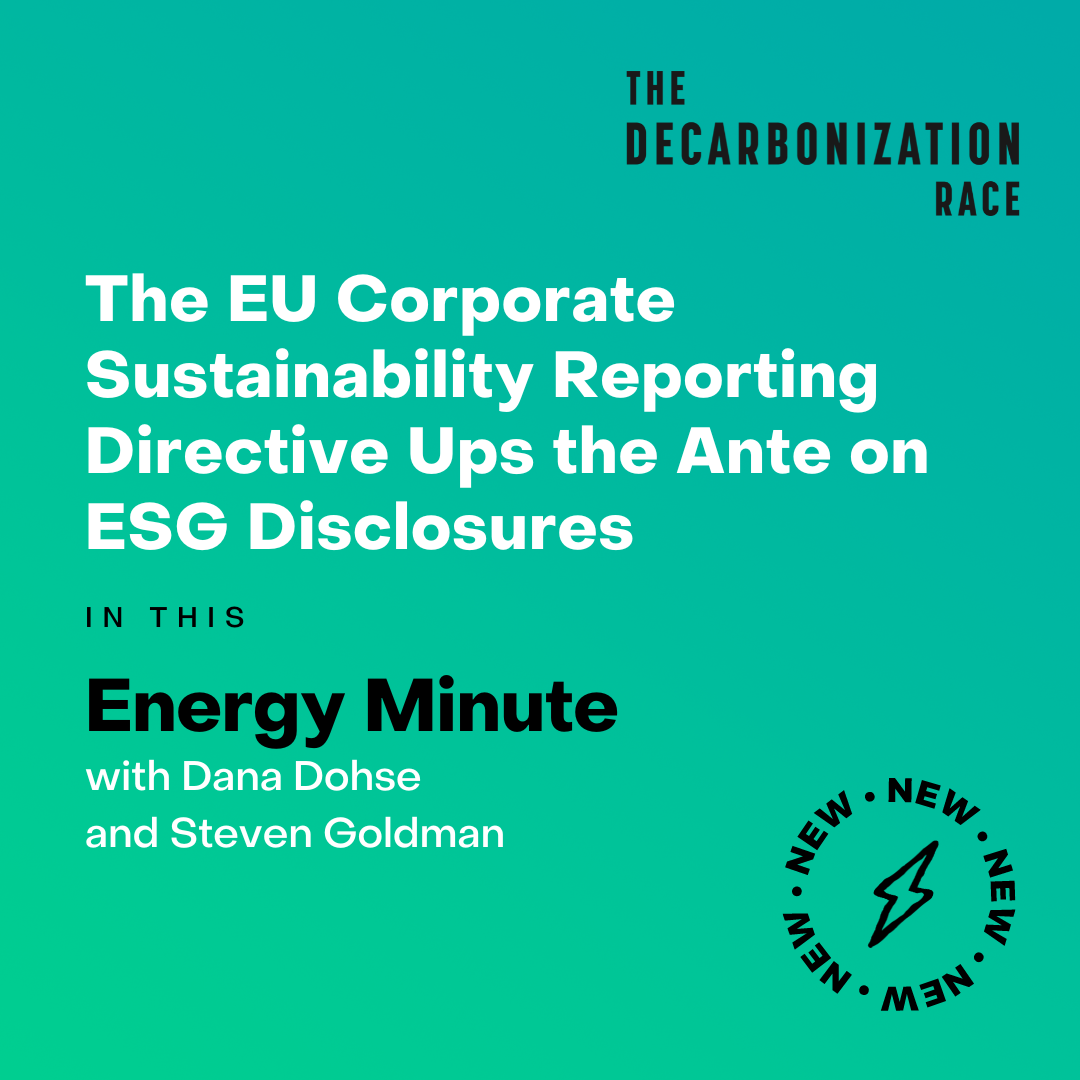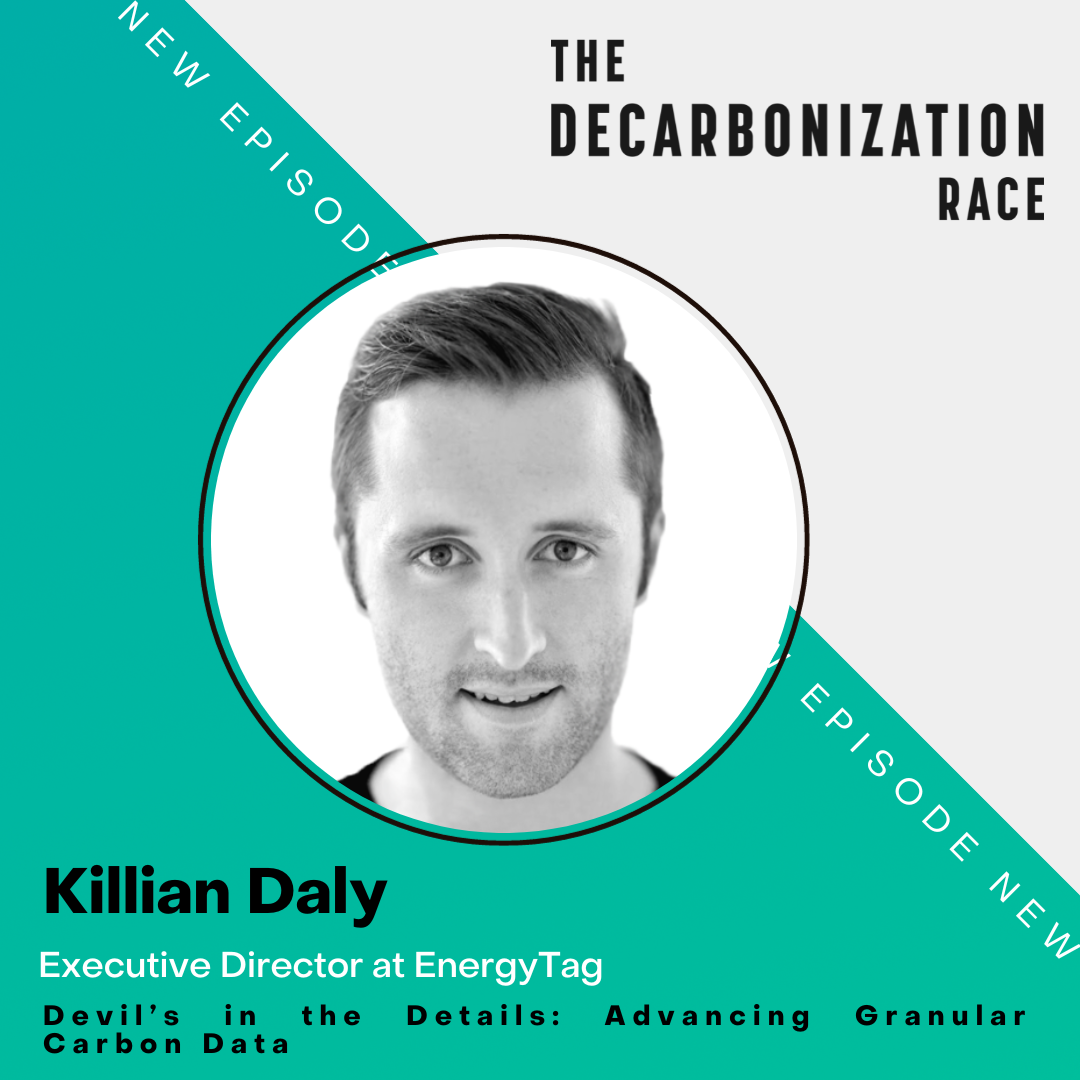Energy Minute: The EU Corporate Sustainability Reporting Directive Ups the Ante on ESG Disclosures
On this Energy Minute episode, Dana Dohse and Steven Goldman take a deep dive into the Corporate Sustainability Reporting Directive (CSRD) that will be taking effect in the European Union in 2024. Under the new legislation, aligning with Paris climate goals and ensuring ethical supply chains will not longer be voluntary practices for proactive risk management.

Listen in as they examine the legislation’s details, requirements, and potential impact on businesses and society, discuss the differences between the CSRD and the proposed SEC rules on climate-focused disclosure, examine how they reflect existing sustainability reporting standards such as SASB/ISSB standards, and analyze the legislation’s implications, and advise companies on how to prepare for compliance.
Key Takeaways
- The EU adopted a “double materiality” approach as the basis of the new legislation, meaning it encompasses not only ESG issues with material impacts on financial performance, but also impacts of the company’s operation on the environment and society.
- Environmental, social, and governance (ESG) factors covered by the CSRD will be significantly more far-reaching than the proposed SEC rules on climate-focused disclosure, encompassing issues including climate change mitigation and adaptation, water and marine resources, equal treatment and opportunities, sustainability risk management and internal controls, and anti-corruption policies, to name a few.
- Unlike the proposed SEC rules, the CSRD explicitly includes Scope 3 emissions in its carbon footprint disclosure requirements.
References
- Press release on the adoption of the CSRD: https://www.europarl.europa.eu/news/en/press-room/20221107IPR49611/sustainable-economy-parliament-adopts-new-reporting-rules-for-multinationals
- https://finance.ec.europa.eu/capital-markets-union-and-financial-markets/company-reporting-and-auditing/company-reporting/corporate-sustainability-reporting_en
- Harvard Law School analysis: https://corpgov.law.harvard.edu/2022/08/23/eu-corporate-sustainability-reporting-directive-what-do-companies-need-to-know/
Transcript
Dana Dohse: Welcome to this week’s Energy Minute. I’m Dana Dohse.
Steven Goldman: And I’m Steve Goldman.
Dana Dohse: We are waiting on the finalization of the SEC rules on climate focused disclosure guidance in the US, which may be delayed until second half, possibly even the fall. So just as the rest of the US looks to California to set the bar for environmental action, companies are looking at how the EU is setting a new bar for corporate sustainability and what companies will be asked to do in regards to acting on climate in human rights.
Steven Goldman: And unlike a number of other laws that take effect in the next decade, the EU Corporate Sustainability Reporting Directive isn’t future tense. Non-EU companies with a significant presence in Europe will have reporting requirements that take effect as early as 2024 for reporting in 2025 if they do business in Europe over certain thresholds.
Dana Dohse: More importantly, if a company is subject to requirements of the CSRD, they will need to report out a wider range of issues than proposed by the SEC rules in areas such as biodiversity, social issues, and supply chain management, which is requiring disclosures of more than 100 key performance indicators.
Steven Goldman: So in this Energy Minute, we’re looking at the European Union’s CSRD, the Corporate Sustainability Reporting Directive. Let’s get into it.
Dana Dohse: Okay. So before we dive in, I think it’s worth covering a little bit about the history of reporting in the EU. This legislation is built to build on top of the existing NFRD, the Non-financial Reporting Directive, and that one will actually remain enforced until the CSRD takes effect into 2024. And those companies that were originally affected by the CSRD, well, they’re the first ones that are going to be affected by this one as well.
So under the NFRD, large companies have to publish information related to environmental matters, social matters, and treatments of employees, respect for human rights, anti-corruption and bribery, diversity on company boards in terms of age, gender, educational, professional backgrounds. And these reporting rules apply to large public interest companies with more than 500 employees. So that covers just over 11,000 large companies and groups across the EU, including listed companies, banks, insurance companies, and really other companies designed by national authorities as public interest entities. And this was passed back in 2014.
Steven Goldman: And so, there’s two major corporate sustainability packages that were passed recently in the EU. The one that we’re going to talk about today is the Corporate Sustainability Reporting Directive. What that’s aimed at is improving the reliability and comparability of sustainability, ESG reporting, and making it better positioned to integrate into financial disclosures. The overall goal is making sure that for companies that are located in the EU or that have significant operations in the EU, that there’s an ease of comparing their performance on sustainability and a range of ESG related issues the same way you would compare financial performance.
Dana Dohse: So are these brand new standards or are they basing this on the existing legislation?
Steven Goldman: So it looks like the subject matter areas are similar to what was under the previous directive, but they’re going to be developing a new set of European sustainability reporting standards that’ll be developed by the organization previously known as the European Financial Reporting Advisory Group, now known as just simply EFRAG. So they’re going to start with a set of common standards that are going to apply across all companies that are subject to reporting needs. And then, as they move forward, they’re also planning to develop sector specific standards, which is similar to how SASB, the Sustainability Accounting Standards Board, now, the part of the ISSB has sector specific standards as well, and the goal is they’re going to have those actually mapped to SASB, ISSB as the issue goes.
Dana Dohse: And so for me, looking at the significance and the motivation is really interesting here. So the EU adopted something they’re calling a double materiality as the basis of their standards. So this encompasses both the ESG impact on financial performance as well as the impact of the company’s operation on the environment and society. So really looking inward as well as outward when they’re thinking about this. So the intent here is to have a common set of KPIs that would be easier to compare from company to company. So that can provide a lot of value, whether you’re an investor or a consumer, just trying to understand, comparing products, comparing investments. Their aim is really to bring a new level of transparency here.
Steven Goldman: And that differs dramatically from the US where most of these disclosures have been voluntary. Now, the EU is requiring these to be submitted so that they can, as a regulatory body, assess and potentially take action against companies that are either not particularly moving to address material impacts or have more egregious externalities that they’re not addressing. So Dana, you’ve been looking into this as well. Who has to report? What size of companies are they expecting that are going to be pulled into this?
Dana Dohse: Absolutely. So the previous law covered about 10,000 companies, and now under the CSRD, we’re looking at about 50,000 companies. And so this covers all private and public companies with at least 500 workers. So companies meeting two of the following three conditions will have to comply with the CSRD. So those would be 40 million euros in net turnover, 20 million euros in assets, or 250 or more employees.
Steven Goldman: And what we saw was that for small and medium enterprises, small and medium businesses aren’t required to do reporting unless they’re listed on regulated markets. But the EU is proposing a potentially separate standards that they could voluntarily use.
Dana Dohse: But one of the big differences between what we’re talking about here, the CSRD and the SEC, is that there are Scope 3 implications. So Scope 3 is required under the CSRD. And so even though some of the small medium businesses won’t be required to comply through their suppliers and their supply chain, there might be knock on effects for them to have to start thinking about their own operational emissions, or their Scope 1 and Scope 2.
Steven Goldman: So in terms of what companies are going to need to report on and by when that’s broken up into the three traditional buckets of ESG. First, there’s environmental factors. So it’s going to be obviously what most companies have front and center is climate change mitigation. So with regards to Scope 1, Scope 2, and where relevant Scope 3 greenhouse gas emissions, it’s also going to cover climate change adaptation. So if they’re facing any risk and need to make disclosures around the need to adapt to changing conditions on the ground, exposure to water and marine resource issues, resource use in the circular economy, and that’s in particular I think going to come into play with anything from automotive to batteries, to solar of how materials are reused. There’s pollution obviously, and then biodiversity and ecosystems.
Then on the S front for social and human rights factors, it’s really under three key areas, equal treatment and opportunities for all, working conditions, and then respect for the human rights, fundamental freedoms and democratic principles and standards established in the International Bill of Human Rights and other core UN human rights conventions.
And then lastly on governance, it’s broken up into a range of areas, how companies are administering and supervising sustainability, how companies are setting up internal control and risk management systems, which is very relevant to companies that are already engaged around SASB standards and how that plays into enterprise risk management, business ethics and corporate culture, especially how companies are staying on top of anti-corruption and anti-bribery policies, how companies are either using or monitoring political influence, including lobbying activity. And then lastly, the management and quality of relationships with customers, suppliers, and the communities affected by the businesses that they do.
Dana Dohse: And so I found it interesting that people will also be required to disclose their sustainability targets and transition plans if they’ve established those in order to ensure that their business model and strategy are compatible with the transition to a sustainable economy. The objective of limiting our global warming in line with the Paris Climate Accord and achieving climate neutrality by 2050, which is in line with the EU goals in the European climate law. So it is quite extensive across all of these areas.
Steven Goldman: And that 2050 target is very much in line with what the Science-Based Targets Institute has developed in terms of any company that’s setting a long range net zero target, you’re already going to have to be looking ahead to that as part of this compliance regime.
Dana Dohse: So as most of our audiences in the United States, I think it makes sense to spend a little bit of time talking about how these requirements compared to what the SEC has proposed already.
Steven Goldman: So Dana, you mentioned earlier materiality. That’s a really big difference between what has been proposed for the SEC’s rules and the CSRD as written and adopted.
So the CSRD is based on the concept of double materiality, which is also known as both impact materiality and financial materiality. That’s looking at how a company is affected by external factors that influence its position development and performance. So it’s outside in, and then the extent to which the company generates effects on the environment society, so inside out.
The SEC’s rules are only focused on what they call single materiality, meaning sustainability related impacts on the company or its enterprise value that can be material. So it’s putting a lot more onus on companies to look more broadly at their impacts and the ways in which the company is affected by the outside world, by external conditions, by what’s happening in communities, what’s happening in markets as they shift, what’s happening with sourcing up and down its supply chain, and then the effects that the company is having as it makes products or services and puts them out to the world.
Dana Dohse: The big difference is what’s motivating this and the legislation behind it. So the SEC is focused purely on the investor view of materiality versus the CSRD, which is also having to take into account the European climate law.
Steven Goldman: Another key difference is around scope. And by that we mean Scope 3. The CSRD does require companies to report out on Scope 3, whereas the SEC rules had made reporting on Scope 3 optional, and we don’t know how that’s going to land until the final SEC rules are released. But from what we can see today, the EU rule does require reporting out on material Scope 3, and that’s going to include upstream purchasing, downstream sold products, goods and transportation, travel and financial investments. So financed emissions.
Dana Dohse: The thing that stood out to me here is they’re requiring as much primary data as possible. So if you’re a company sitting here, you’re thinking about lifecycle assessments on the products you purchase and now you’re thinking about how do you really get deeper into your supply chain and thinking about things like getting robust, transparent and verifiable data.
Steven Goldman: It’s going to require, I think, a lot more third party auditing. I think it’s going to require a lot more companies to ask more of their suppliers. And I think we’ve talked about it on the show before around this notion of operational decarbonization where companies are getting a grip around their Scope 1 and 2, the starting point is going to be for suppliers to start in on their operational decarbonization and then looking at their inputs into what they provide to companies as part of elements of the supply chain. Could be ingredients or products, it could be production processes, but looking at how they can start gathering the same information and providing it upward because it’s not optional. They’re going to have to provide this in as timely fashion as they can.
Dana Dohse: Right. And for me, this is where it starts to become even more far-reaching because it’s not only companies that are residing in the EU or have significant business there people selling into the EU. There’s going to be a significant change to the expectations that come with those contracts, that come with the supply chain that’ll start to ripple out. And that’ll be really interesting to watch, especially as we anticipate the SEC guidance, some of these things could already be in place.
Steven Goldman: And also the expansiveness around environmental areas in particular like water and ecosystems, not just carbon emissions and getting into more labor issues. Also, the range of industries is pretty diverse. I think we were reading that it’s going to set out disclosure requirements for no less than 40 industries. We’d have to go and look at how that matches up to SASB and the span of industries they offer. But it’s definitely for required disclosures, it’s going to be quite broad.
Dana Dohse: So Steven, I know you looked into some of the controversies around this and the likelihood of how this might be amended. What did you find?
Steven Goldman: The one big note that I found was that companies, while they’re going to need to engage with their value chains and their suppliers for the first three years of the CSRD, what we were reading was that if information regarding their value chains not available, they can elect to explain their inability to obtain such information rather than comply fully with the disclosure requirement at first. It’s interesting that’s written to the law because that’s pretty much what’s been outlined in the SASB approach, that companies that can’t access sufficient information or are still in the process of data gathering can simply choose to omit and explain rather than put forward incomplete information or put forward a potentially misleading picture if they don’t have all the data.
Dana Dohse: And you’ve hit on something, an interesting theme here that keeps bubbling up in research, which is really around how much risk that this is opening up for companies. And that ties back to this need for auditable data that is really trustworthy because there’s this balancing act that needs to take place in terms of being transparent, disclosing what you’re doing, but also doing it in a way that you’re not opening yourselves up for further scrutiny.
Steven Goldman: Well, and also not opening yourself up to greenwashing accusations because you have data you can stand behind. It’s going to be really critical. The other thing we’ve seen too is the SEC has started taking compliance actions against companies that are greenwashing. And I would only have to imagine that the EU would be more zealous about that compared to US authorities.
Dana Dohse: I guess only time will tell. So what should companies do now to start getting moving on their compliance?
Steven Goldman: The first thing is like the boy scouts or girl scouts, be prepared. Those first deadlines aren’t far away. You have to start gathering data for your first reporting cycle in 2025 if you are one of the companies that is required to comply with the needs of the CSRD. So you need to identify the extent to which you’re subject to reporting. And if you are subject, you need to build out all the processes, procedures, internal controls that you would need and bring together the resources to manage those obligations. And that is not a small task for companies that are not prepared yet.
The other thing is that the expectation is the EU is going to continue to evolve legislation like this over the next few years, meaning it may become more stringent. And so, if companies can get prepared now and start understanding their carbon footprint, their environmental impacts, the relationships they have in communities, any vulnerabilities they have around their workforce or their relationships with labor, getting the right internal controls in place on governance and making sure that they’re able to source all the right data, all of that will help get them positioned for anything that may be coming down the pike.
Dana Dohse: So speaking out of our own book a bit, but this underscores this importance of data. How do you get more granular data? How do you find that best available data across your entire value chain, across your entire energy footprint to really prepare for this? Because to Steven’s point, this is only projected to get more stringent.
Steven Goldman: And also from our book, it’s also about creating opportunity. If you have access to strong data, if you can get insights into the way that your company is operating at a very detailed level, you can start to see opportunities in how you can innovate in how you can reduce energy costs, and how you can source clean energy, ideally at less cost than you would be with grid power. And try to find ways that it’s going to also help your bottom line.
Dana Dohse: It’s so hard to project something, to manage something without truly understanding it first. That really comes back to the importance of data.
Steven Goldman: The last piece I would throw out is also that it’s felt like we are coming out of a lot of supply chain bottlenecks, but we don’t know what’s around the next curve. And companies that are able to have a strong grip on not just what they’re doing operationally, but what they’re doing in their supply chain are going to be well positioned to get ahead of that due planning around procurement, due planning around future needs, and be able to get ready so that they’re going to be less surprised, less exposed, and less vulnerable to future risks and bottlenecks.
Dana Dohse: We focus a lot on the obligation to companies, but we’d be remiss not to mention the flip side. This is huge win from an environmental standpoint. It’s huge progress towards us as a planet meeting the goal set forth by the Paris Agreement. And for me, personally, this is hopeful. This is positive, this is good change in the right direction.
Steven Goldman: Of course. And it’s also, as we look ahead to the energy transition, we need to have a tight grip on how companies are working with communities on how they’re working through labor issues to make sure that no one is being exploited in the process that we’re closing the loop on materials, as we’ve talked about in previous segments on the show. This is an opportunity for companies to start being proactive, even if they’re being pressed into doing it through disclosure requirements. This is helping get everyone to the same practices and the same disclosure areas so that we’re all moving in the right direction, that practices are more ethical, that sourcing is going to be handled with the right stringency and the right internal controls, and that companies are frankly being more transparent.
Dana Dohse: Absolutely. And if I’m a business leader, I’m also looking at this as an opportunity to differentiate myself, an opportunity to be a leader, to step forward and blaze the trail on how can I reimagine my business in this changing world.
Steven Goldman: And so next time we’ll delve into the second part of the regulations that have been passed, the CS3D, which sounds like a transformer or I don’t know, like a military vessel designation or something, but the parallel regulations that the EU has issued around corporate sustainability due diligence, and how companies have to also get a tight grip on their supply chains. So we’ll delve into that on the next Energy Minute.
Dana Dohse: Thanks for joining us for this week’s Energy Minute. For more of the latest news in sustainability and decarbonization, visit cleartrace.io.



